Lo Mein is a noodle dish that you will easily find on the menu at your favorite Chinese restaurant. It’s a dish that is similar to chow mein, but the main difference between chow mein and lo mein is that different methods are used to make these stir-fry noodles. With chow mein, noodles are fried to crispness, while lo mein noodles are boiled to softness. This recipe is versatile, because you can interchange your choice to be beef, pork, chicken or make it vegetarian by adding tofu! No matter what you choose, this recipe is just as good as any Chinese take-out– only you made this at home!

Every so often, I get a craving for Chinese food! Fortunately, we have a local restaurant that is clean, has fast and friendly service and the food is good. However, it’s a 30 minute drive from home, so take-out isn’t the most ideal way to scratch my itch for Chinese food. Instead, I’m learning how to make Chinese recipes at home.
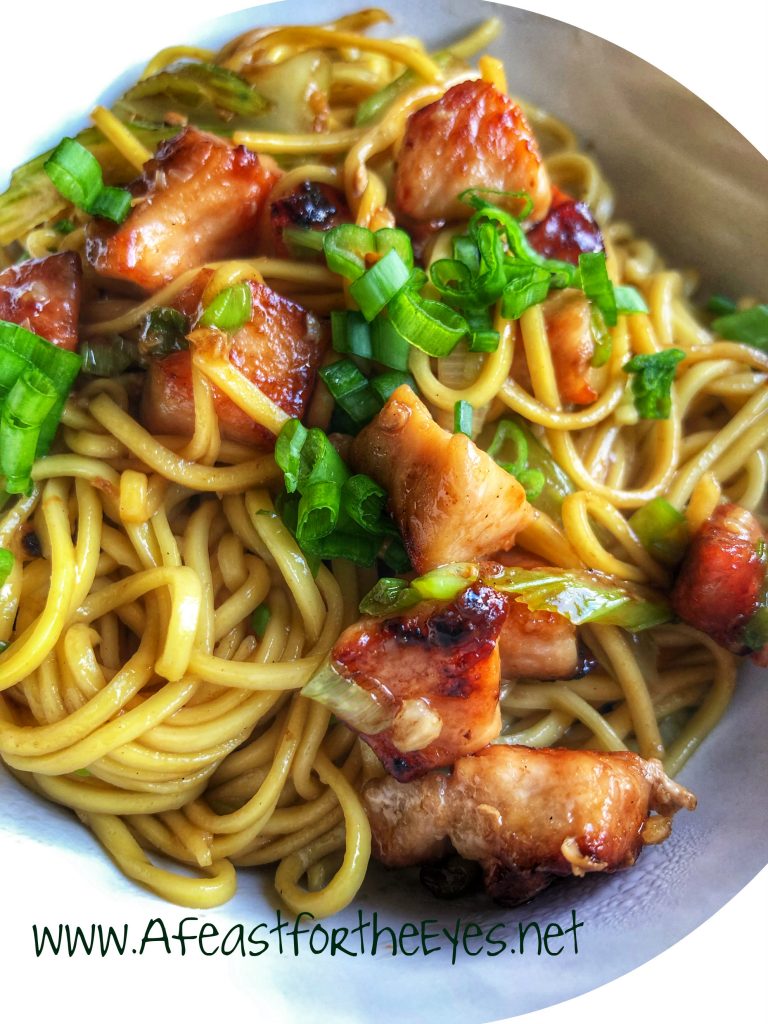
In recent years, I have switched to buying most of my cookbooks to Kindle format. While I prefer holding a cookbook in my hands, the “old school way”, my limited bookshelf space is filled to capacity– and I couldn’t even fit a sheet of paper in between my cookbooks! Every so often, I’ll spot a kindle version of a cookbook on sale– and luckily, “The Chinese Takeout Cookbook” by Diane Kuan is one I downloaded at a bargain price.
I will jump at any opportunity to learn how to make recipes with Asian ingredients and flavors. I bookmarked quite a few recipes from this cookbook, and one of them was the Roast Pork Lo Mein. I didn’t have Chinese Barbecue Pork on hand that was listed as the ingredients (that recipe is also included in the cookbook), but I did have boneless pork loin that I had thawed from our freezer.

I decided to add sliced celery to the “mix” along with scallions, garlic and ginger. NOTE: I usually keep fresh ginger on hand, storing some in the freezer. Recently, I discovered this handy dandy crushed ginger in the freezer section of my local Trader Joe’s. It’s definitely a great shortcut, so this is what I used. Since Lo Mein is a “stir fry” dish, the key is to chop and prepare all of your ingredients in advance. Vegetables are done!
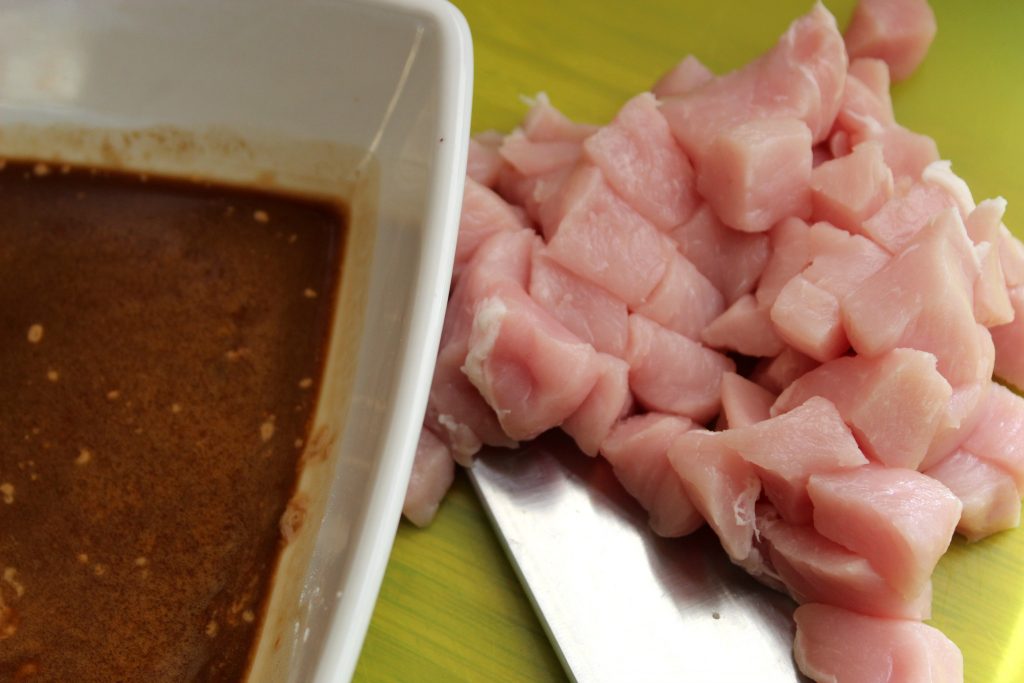
To prepare the pork, I borrowed a recipe from Cook’s Country. Recently, I made their Simple Pork Fried Rice recipe (recipe to come, when I take better photos) and it was a success. Cook’s Country doesn’t really explain why they add corn starch, baking soda to the brown sugar and soy sauce– but it works great!

Can you substitute chicken for pork? Yes! Beef? I don’t see why not. Either way, the pork has marinated for at least 15 minutes (or it can be refrigerated for up to an hour).
All I can say is that I loved how the marinade tasted and the brown sugar developed a beautiful dark brown color! Here, I’ve added the marinated pork into a hot non-stick skillet. To get that beautiful brown crust, you want to leave the meat untouched for at least 2 minutes! I like to use a large spatula to flip them over for another minute or two (or just shake the pan to flip it). Remove the meat and set aside.
We can’t have lo mein without Chinese noodles, can we? I can easily find them in my local grocery store. But, in a pinch, you could use spaghetti. What’s important, is the the noodles are not overcooked. We want them “al dente” (to the tooth). My Chinese noodle package said to cook for 3 minutes, then to drain and rinse with cold water. Set aside.
In case you are curious, the difference in the noodles is that the Chinese noodles are made with wheat flour, and Italian spaghetti noodles are made with durum flour.
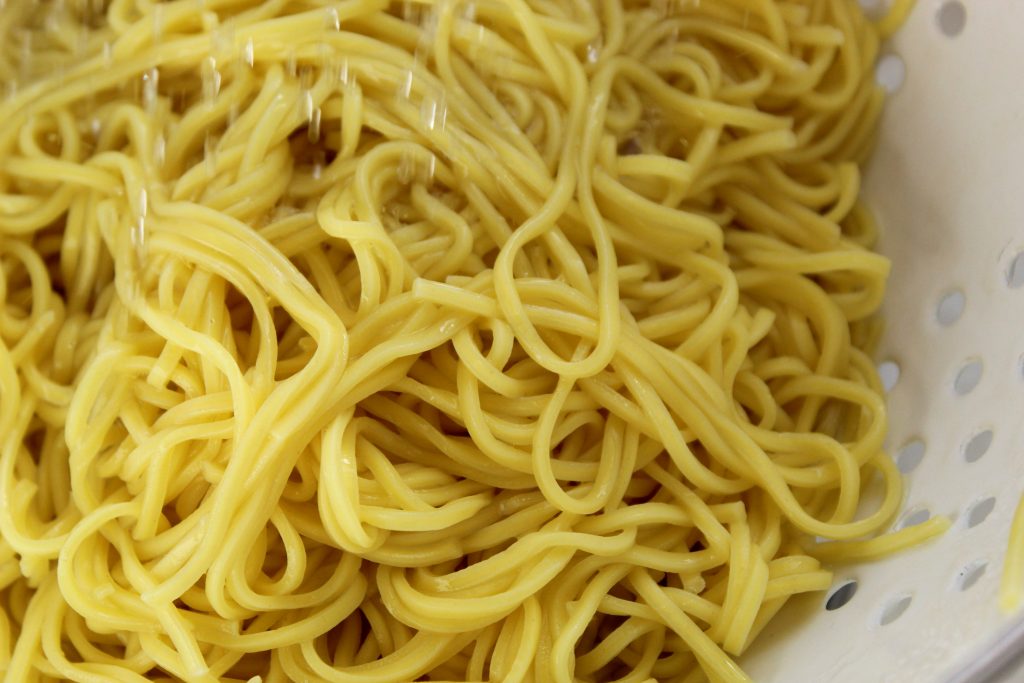
The vegetables are prepared, the pork has marinated and been cooked, and the noodles are cooked and drained, and a little sesame oil is added until well coated..
Let’s talk about stir fry! You don’t have to own a Chinese wok to make stir-fry recipes. You can use a large frying pan (with tall sides is ideal). However, I did invest in a carbon-steel wok (with a lid) a few years ago, and I absolutely love it! I watched a video on how to properly season one (very similar to a cast-iron frying pan).
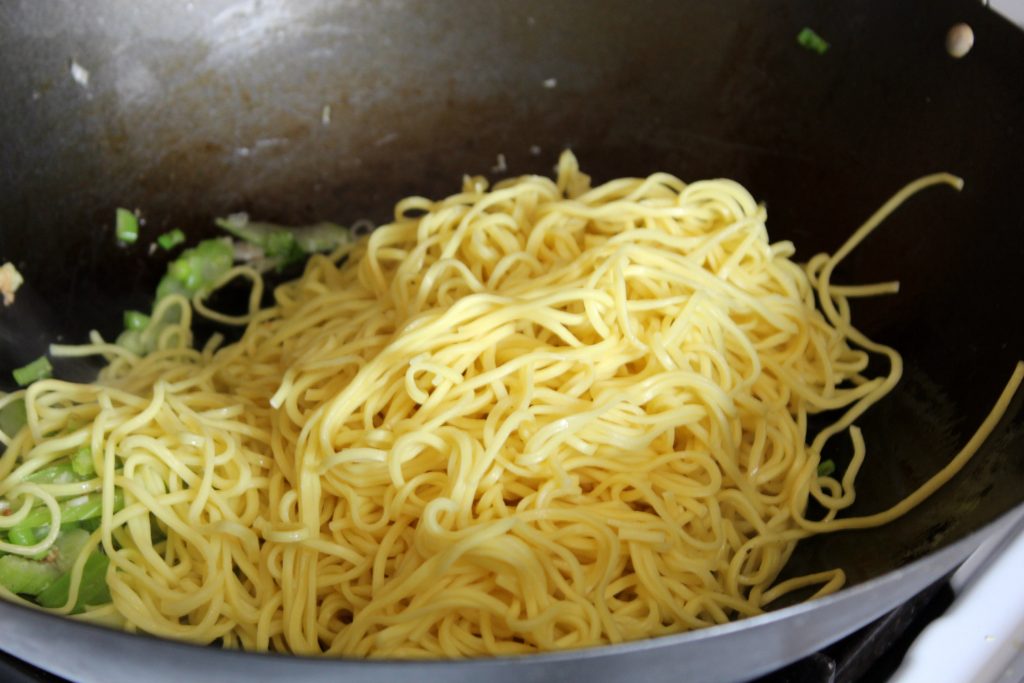
My prep work took about 30 minutes to complete. The stir-fry part takes only minutes! When stir-frying, I use an oil that has a high smoke point (olive oil isn’t one of them), so I use either peanut, avocado or vegetable oil. First, I add the ginger, celery and the white parts of the scallions and stir them around for about 20 seconds. Last, add the garlic, because you don’t want it to burn. NOTE: The recipe adds sliced shiitake mushrooms, which I didn’t have on hand. Add the noodles and then the pork. Done and done!
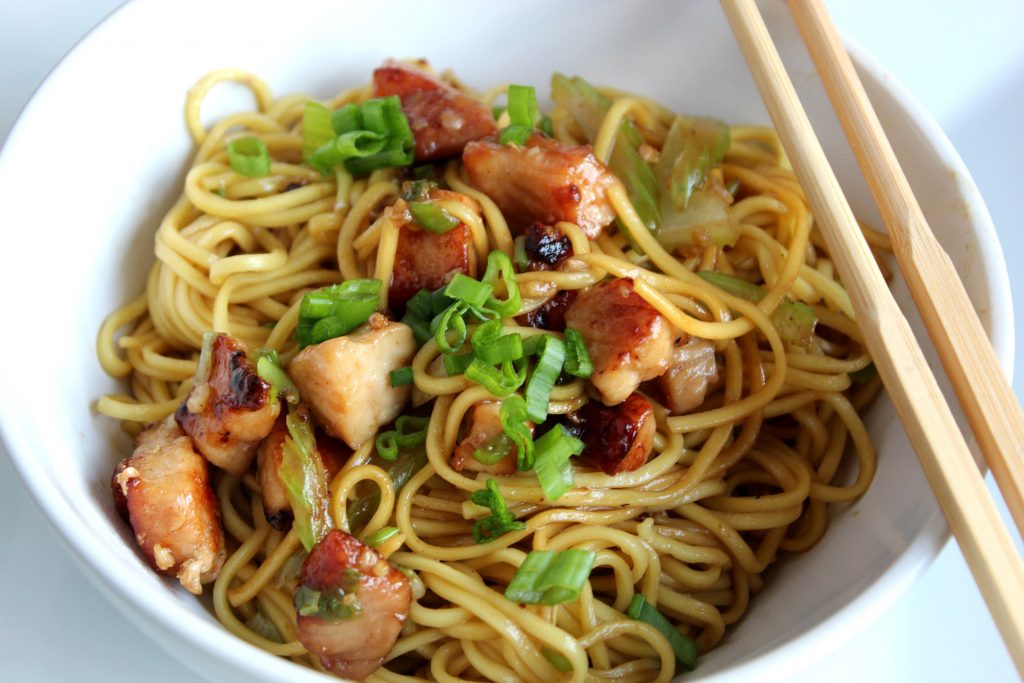
TASTING NOTES: Oh, wow! I was so happy with how easy and delicious the sauce was! I can honestly say that this Lo Mein captured the flavor of our local Chinese restaurant! I plan to make this recipe one that I will make over and over again. I’m excited to try swapping this out for chicken… or shrimp!
Additional information: Because we enjoy Asian recipes, these are the ingredients I try to keep on hand, because they are commonly used: Dry Sherry, Oyster Sauce, Hoisin Sauce, Fish Sauce, sesame oil, low-sodium soy sauce, ginger and scallions.
Pork Lo Mein – Made Easy
Ingredients
For the marinade:
- 4 tsp low sodium soy sauce
- 1 Tbsp brown sugar packed
- 1 tsp corn starch
- 1/4 tsp baking soda
For the Lo Mein:
- 12 ounces Chinese egg noodles thin dried; or spaghetti noodles
- 1 ½ Tablespoons sesame oil
- 1/2 pound boneless pork chops other substitutes: chicken, or boneless country-style pork ribs
- 1 1/2 tsp fresh ginger minced or grated
- 3 green scallions sliced into two-inch lengths (I sliced mine thinner and separated the white ends from the green)
- 2 stalks celery sliced thin; optional
- 1 1/2 tsp garlic minced
- 5 shiitake mushrooms, thinly sliced optional
- 1 Tbsp vegetable oil or peanut oil
For the stir-fry sauce:
- 3 Tbsp low-sodium soy sauce
- 1 1/2 Tbsp oyster sauce
- 1 1/2 Tbsp dry sherry or Chinese rice wine
- 1 1/2 tsp honey
Instructions
Marinate the meat:
- Combine pork, 2 teaspoons soy sauce, sugar, cornstarch, and baking soda in bowl. Let pork mixture sit for at least 15 minutes, or cover and refrigerate for up to 1 hour.
Prepare noodles:
- Bring a medium pot of water to a boil and cook the noodles according to the package instructions. You want them to al dente, or the minimum amount of time suggested by the package.
- Drain the noodles, rinse under cold water, and drain again, shaking well to remove the excess water. Return the noodles to the pot, toss with the sesame oil until the noodles are well coated and set aside.
For the stir-fry sauce:
- In a small bowl, combine the soy sauce, oyster sauce, rice wine (or dry sherry) and honey. Whisk together and set aside.
For the pork:
- Heat 1 tablespoon oil in 12-inch nonstick skillet over high heat until just smoking. Add pork in single layer and cook, without stirring, until browned, about 2 minutes. Stir pork and continue to cook, stirring frequently, until dark brown on all sides, about 3 minutes longer.
Transfer to clean bowl.
Cook the stir-fry:
- Heat a wok or large skillet over high heat until a bead of water sizzles and evaporates on contact. Add the peanut oil and swirl to coat the bottom.
- Add the ginger, garlic, scallions, celery (if using) and stir-fry until aromatic, about 30 seconds. Add the mushrooms (if using) and cook until softened.
- Add the noodles and pork. Add the stir-fry sauce mixture and toss with tongs (or chopsticks) until the noodles are well coated with sauce. Transfer to a plate and serve.
Notes
Nutrition









Looks very good Debbie and makes me want to whip up a batch.
I hope that you do, Larry!
Hi Debby, what kind of pork do you use. Roast?
In the recipe I list
Pork loin or that you could use a boneless pork chop or country style pork rib. 😀
I don’t see ginger in the ingredients list – how much did you add?
I’m so sorry! I forgot to add 1 1/2 tsp fresh ginger. The recipe card has been updated. Thank you for pointing that out.
Very good!